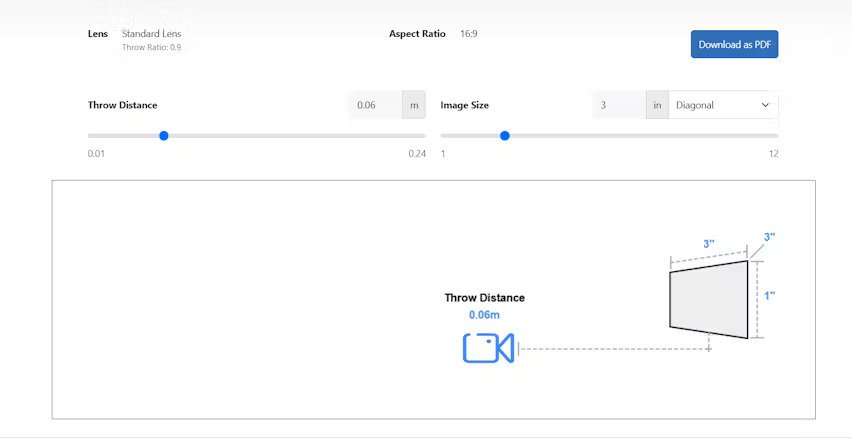XTEN-AV understands the challenges of maintaining crystal clear projection in any space. One of the most common questions home theater and office users ask is why is my projector blurry. While there are several technical factors that can affect a projector’s clarity, ambient light is often a major culprit that people overlook. In this blog, we will explore how ambient light impacts projector sharpness, why it makes images appear blurry, and practical steps on how to fix blurry projector issues.
Understanding Projector Sharpness
Before diving into how ambient light affects your projector, it is essential to understand what projector sharpness means. Sharpness refers to how clearly and distinctly your projector displays images. A sharp image has well-defined edges, vibrant details, and accurate colors. When a projector is blurry, the image appears soft, washed out, or out of focus, making it difficult to enjoy movies, presentations, or gaming. Many users report situations where their projector is blurry despite careful setup, and ambient light is often the hidden factor.
How Ambient Light Impacts Projector Clarity
Ambient light is any light present in a room that is not emitted by the projector. This can include sunlight from windows, ceiling lights, lamps, or even reflections from walls. Excessive ambient light affects a projector in several ways:
- Washed-Out Colors and Reduced Contrast
Projectors work by projecting light onto a screen. When additional light enters the room, it competes with the projector’s output. This causes the projected colors to appear washed out and reduces the contrast between dark and bright areas. For example, blacks may look gray, and subtle shades may blend together, making the image look blurry. Even if the lens and focus are perfect, ambient light alone can make a high-quality projector appear blurry. - Perceived Blur Due to Low Brightness
A common misconception is that a blurry projector always means a lens problem. In reality, when ambient light is too high, the human eye perceives images as less sharp because the projector’s brightness is insufficient to overcome the surrounding light. This is especially noticeable in rooms with large windows or strong overhead lighting. Users often ask why is my projector blurry during daytime viewing, and ambient light is usually the reason. - Glare and Reflections
Certain surfaces in a room, such as glossy walls, mirrors, or polished furniture, can reflect ambient light into the projector image. These reflections create glare that interferes with the clarity of the projection. The resulting effect makes edges look soft, and text or fine details become difficult to read. This is another reason why my projector is blurry even if the projector itself is properly aligned and focused. - Impact on Different Projector Types
Ambient light affects different projectors in varying degrees. For example, standard home theater projectors may struggle in bright rooms, while high-lumen projectors designed for conference rooms can better handle ambient light. However, even the brightest projector will eventually show reduced sharpness if the ambient light is too strong. Knowing how your projector interacts with ambient light is crucial in understanding how to fix blurry projector issues.
How to Identify If Ambient Light Is Causing Blurry Images
Determining whether ambient light is the cause of a blurry projector is relatively straightforward. Here are some indicators:
- The image appears sharper when you turn off room lights.
- Blurriness increases during daytime when sunlight enters the room.
- Projector settings, lens focus, and placement have been checked, yet the image remains soft.
If these signs are present, it is likely that ambient light is the primary factor affecting your projector’s clarity.
Practical Ways to Reduce Ambient Light Effects
XTEN-AV emphasizes that solving blurry projector issues due to ambient light requires a combination of environmental adjustments and projector optimization. Here are actionable steps:
- Control Natural Light
Use blackout curtains, blinds, or shades to limit sunlight in the room. Rooms with large windows benefit the most from light-blocking treatments. Even partial sunlight can dramatically affect image sharpness, so consider using heavy curtains that prevent any light from entering the projection area. - Optimize Room Lighting
Adjust or dim ceiling lights, lamps, or other sources of artificial light. Avoid placing bright lights directly behind or near the screen. Consider using indirect lighting for general illumination instead of direct overhead lights. Reducing overall room brightness enhances contrast and makes the projected image appear sharper. - Choose a High-Gain or Ambient Light Rejecting Screen
Not all screens are created equal. Standard projector screens reflect light equally from all angles, which means ambient light reduces image clarity. High-gain screens amplify projector brightness, while ambient light rejecting (ALR) screens are designed to block reflected light from the room. Using the right screen can make a blurry projector image significantly sharper without changing the projector itself. - Increase Projector Brightness Settings
Many projectors allow users to adjust brightness and contrast. While this does not completely solve excessive ambient light issues, it can help counteract minor blurring effects. Check your projector’s menu for brightness, lamp mode, or dynamic contrast settings to optimize sharpness. - Proper Projector Placement
Projector placement can influence how ambient light affects your image. Avoid projecting onto surfaces that are near bright light sources. Keeping the projector perpendicular to the screen and ensuring the lens is clean will also help reduce perceived blur. - Consider Projector Upgrade for Bright Environments
In some cases, no amount of room adjustment will completely solve blurriness caused by ambient light. XTEN-AV recommends considering projectors with higher lumens specifically designed for bright spaces. These projectors are more resilient to ambient light and maintain sharper images even in rooms that are not completely dark.
Other Factors That Can Compound Ambient Light Blurring
While ambient light is a major factor, it can interact with other issues to make images even blurrier:
- Dirty or Degraded Lens: Dust or smudges on the lens scatter light, and ambient light amplifies this effect. Regular lens cleaning can help maintain clarity.
- Screen Material: Certain fabrics or materials reflect light poorly, causing a soft image. Using a professional projection screen can improve sharpness.
- Incorrect Focus or Keystone Settings: Even slight misalignment in focus or keystone correction can make images appear blurry. Ambient light intensifies these imperfections.
Why Understanding Ambient Light Is Crucial for Home Theater and Office Use
Many users invest in high-quality projectors and wonder why is my projector blurry despite following setup instructions. Understanding the role of ambient light is critical for both home theater enthusiasts and office users. For home theaters, it ensures an immersive movie experience without washed-out images. For offices and classrooms, reducing ambient light improves readability and professionalism in presentations. techners
How to Fix Blurry Projector Issues Caused by Ambient Light
Addressing ambient light-related blurriness involves a combination of strategies:
- Evaluate and control natural light sources.
- Reduce artificial lighting during projection.
- Use ALR or high-gain screens for enhanced image reflection.
- Optimize projector brightness, contrast, and placement.
- Consider projector upgrades for higher brightness and better contrast ratios.
By following these steps, most users find a significant improvement in image sharpness. Regular maintenance, including lens cleaning and checking screen condition, complements these adjustments.
Common Misconceptions About Projector Blur and Ambient Light
Many users assume that blurry images are always a result of projector defects. However, ambient light often masquerades as lens or focus problems. Another misconception is that brighter projectors alone solve the issue. While high-lumen projectors help, they are not a complete solution without controlling room light and using the right screen. Understanding these nuances ensures users target the correct cause and avoid unnecessary projector replacements or repairs.
Conclusion
Ambient light is a silent yet powerful factor that affects projector sharpness and can make even a high-quality projector appear blurry. XTEN-AV emphasizes that recognizing the impact of natural and artificial light, along with optimizing room setup, screen type, and projector settings, is essential to achieving crisp, clear images. If you find yourself asking why is my projector blurry or how to fix blurry projector issues, consider ambient light as a primary culprit. By taking practical steps such as controlling light, using appropriate screens, and adjusting projector settings, you can enjoy sharp, immersive projection experiences in both home and professional environments. Remember, even a minor adjustment to light management can dramatically enhance your viewing quality, ensuring your projector delivers the clarity you expect.
















Leave a Reply